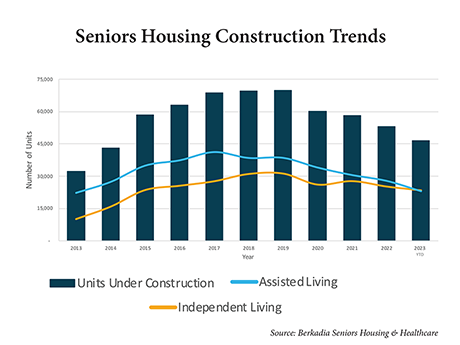By Berkadia Seniors Housing & Healthcare
Like many sectors within the commercial real estate (CRE) industry, the seniors housing market faced headwinds over the past year, largely due to tightening financing conditions and widespread economic uncertainty. However, based upon research and anecdotal evidence from the clients and companies we serve in the seniors housing space, we believe the sector is well positioned to bounce back and generate positive operating results for the remainder of 2023 and into 2024. View a higher resolution version of the construction trends graph above here.
Fundamentals that Encourage Optimism
As debt markets begin to normalize, a more positive outlook awaits the seniors housing market. In the short-term, rising occupancy rates and positive rent growth offer optimism. In the long-term, the aging Baby Boomer population, along with a drastic decline in new development, offers solace to owners, operators and lenders within the sector.
Occupancy Rates
Median occupancy for seniors housing has reached 88.7 percent as of the end of the third quarter of 2023, up a robust 2.7 percent year-over-year. Net absorption has increased 12.9 percent annually as over 13,175 net units have been absorbed across all asset types. With the number of distressed/underperforming communities coming to market, new investors will be able to price monthly rental rates at an appropriate level to drive new resident move-ins, which will result in continued growth in occupancy.
The largest factor impacting seniors housing occupancy rates for the remainder of 2023 and start of 2024 will be the continued leasing of current supply, along with new developments coming online within the next two quarters.
New construction starts are down 50 percent from 2021 and by the end of 2024, the pipeline is expected to hit its lowest level in a decade, with 75 percent of the current pipeline projected to be delivered by the end of the end of 2024.
Additionally, the population of Americans over the age of 80 continues to grow. Seniors housing utilization has already surpassed pre-pandemic levels, which provides evidence for the desire of the Baby Boomer population to utilize seniors housing communities. This utilization along with rent concessions and implementation of new payer sources — such as managed care providers — will be executed with occupancy growth in mind.
Rent Growth
Another fundamental driving optimism in the sector is rent growth. A number of the largest owners of seniors housing have reported that their operating partners are receiving very low levels of pushback as they continue to increase market rents. With continued strong returns in the equity markets, a resilient housing market and the recent Social Security cost of living increase, seniors have ample liquidity and the ability to withstand increased rent growth.
Additionally, several operators are beginning to explore new care delivery models and partnerships that act as new revenue sources. Some instances include partnerships with local healthcare providers, fitness or wellness center as well as pharmacies — all of which are working to generate continued NOI growth in the sector. According to NIC data, rent growth is exceeding the growth in wage costs for the first time since 2017, leading to improving margins.
Investing in Talent
In times of economic uncertainty, it’s common to see specialty practice groups at CRE firms face cutbacks. While some shops face closures or reduced team numbers, Berkadia Seniors Housing has continued to grow its team with five strategic new hires in 2023 alone. The five new team members, based across the United States, have a combined 79 years of Seniors Housing industry experience across a variety of asset classes. Investing in people remains a show of optimism and belief in the strong fundamentals demonstrated by the seniors housing market. Berkadia now boasts nearly 50 full-time seniors housing professionals across its investment sales, mortgage banking and servicing platforms.
Moving into the Fourth Quarter and Beyond
Though the COVID-19 pandemic and more recent economic turmoil have caused headwinds for seniors housing in the United States, the market continues to show signs of a strong recovery. The near and long-term outlook for the market remains positive. The aging population of Baby Boomers is driving demand and rapid advancements in technology and healthcare, allowing seniors to remain active and independent for longer periods of time.
Strong fundamentals and an increase in demand for high-quality, well-managed properties are providing opportunities for seniors housing investors, operators and lenders who have shown increasing adaptability to changing market conditions — allowing them to find success in the ever-changing industry.
— Berkadia is a content partner of Seniors Housing Business. Learn more about Berkadia Seniors Housing & Healthcare here.

